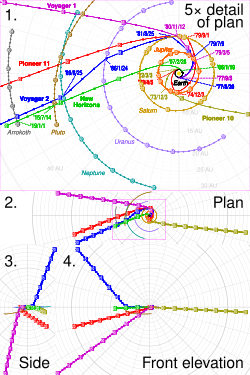
Back Voyager 2 AF Voyager 2 ALS Voyager 2 AN فوياجر 2 Arabic ڤواياجور 2 ARY Voyacer 2 AZ وویجر ۲ AZB Voyager 2 BAN Voyager 2 BAT-SMG Вояджэр-2 BE
 Artist's rendering of the Voyager spacecraft design | |
| Mission type | Planetary exploration |
|---|---|
| Operator | NASA / JPL[1] |
| COSPAR ID | 1977-076A[2] |
| SATCAT no. | 10271[2] |
| Website | voyager |
| Mission duration |
|
| Spacecraft properties | |
| Manufacturer | Jet Propulsion Laboratory |
| Launch mass | 721.9 kilograms (1,592 lb)[3] |
| Power | 470 watts (at launch) |
| Start of mission | |
| Launch date | August 20, 1977, 14:29:00 UTC |
| Rocket | Titan IIIE |
| Launch site | Cape Canaveral LC-41 |
| Flyby of Jupiter | |
| Closest approach | July 9, 1979 |
| Distance | 570,000 kilometers (350,000 mi) |
| Flyby of Saturn | |
| Closest approach | August 26, 1981 |
| Distance | 101,000 km (63,000 mi) |
| Flyby of Uranus | |
| Closest approach | January 24, 1986 |
| Distance | 81,500 km (50,600 mi) |
| Flyby of Neptune | |
| Closest approach | August 25, 1989 |
| Distance | 4,951 km (3,076 mi) |
Large Strategic Science Missions Planetary Science Division | |

Plot 1 is viewed from the north ecliptic pole, to scale.
Plots 2 to 4 are third-angle projections at 20% scale.
In the SVG file, hover over a trajectory or orbit to highlight it and its associated launches and flybys.
Voyager 2 is a space probe launched by NASA on August 20, 1977, as a part of the Voyager program. It was launched on a trajectory towards the gas giants Jupiter and Saturn and enabled further encounters with the ice giants Uranus and Neptune. It remains the only spacecraft to have visited either of the ice giant planets, and was the third of five spacecraft to achieve Solar escape velocity, which allowed it to leave the Solar System. Launched 16 days before its twin Voyager 1, the primary mission of the spacecraft was to study the outer planets and its extended mission is to study interstellar space beyond the Sun's heliosphere.
Voyager 2 successfully fulfilled its primary mission of visiting the Jovian system in 1979, the Saturnian system in 1981, Uranian system in 1986, and the Neptunian system in 1989. The spacecraft is now in its extended mission of studying the interstellar medium. It is at a distance of 138.27 AU (20.7 billion km; 12.9 billion mi) from Earth as of November 2024[update].[4]
The probe entered the interstellar medium on November 5, 2018, at a distance of 119.7 AU (11.1 billion mi; 17.9 billion km) from the Sun[5] and moving at a velocity of 15.341 km/s (34,320 mph)[4] relative to the Sun. Voyager 2 has left the Sun's heliosphere and is traveling through the interstellar medium, though still inside the Solar System, joining Voyager 1, which had reached the interstellar medium in 2012.[6][7][8][9] Voyager 2 has begun to provide the first direct measurements of the density and temperature of the interstellar plasma.[10]
Voyager 2 remains in contact with Earth through the NASA Deep Space Network.[11] Communications are the responsibility of Australia's DSS 43 communication antenna, located near Canberra.[12]
- ^ "Voyager: Mission Information". NASA. 1989. Archived from the original on February 20, 2017. Retrieved January 2, 2011.
- ^ a b "Voyager 2". US National Space Science Data Center. Archived from the original on January 31, 2017. Retrieved August 25, 2013.
- ^ "Voyager 2". NASA's Solar System Exploration website. Archived from the original on April 20, 2017. Retrieved December 4, 2022.
- ^ a b "Voyager – Mission Status". Jet Propulsion Laboratory. National Aeronautics and Space Administration. Archived from the original on January 1, 2018. Retrieved July 9, 2023.
- ^ Staff (September 9, 2012). "Where are the Voyagers?". NASA. Archived from the original on March 10, 2017. Retrieved September 9, 2012.
- ^ University of Iowa (November 4, 2019). "Voyager 2 reaches interstellar space – Iowa-led instrument detects plasma density jump, confirming spacecraft has entered the realm of the stars". EurekAlert!. Archived from the original on April 13, 2020. Retrieved November 4, 2019.
- ^ Chang, Kenneth (November 4, 2019). "Voyager 2's Discoveries From Interstellar Space – In its journey beyond the boundary of the solar wind's bubble, the probe observed some notable differences from its twin, Voyager 1". The New York Times. Archived from the original on April 13, 2020. Retrieved November 5, 2019.
- ^ Gill, Victoria (December 10, 2018). "Nasa's Voyager 2 probe 'leaves the Solar System'". BBC News. Archived from the original on December 15, 2019. Retrieved December 10, 2018.
- ^ Brown, Dwayne; Fox, Karen; Cofield, Calia; Potter, Sean (December 10, 2018). "Release 18–115 – NASA's Voyager 2 Probe Enters Interstellar Space". NASA. Archived from the original on June 27, 2023. Retrieved December 10, 2018.
- ^ "At last, Voyager 1 slips into interstellar space – Atom & Cosmos". Science News. September 12, 2013. Archived from the original on September 15, 2013. Retrieved September 17, 2013.
- ^ NASA Voyager – The Interstellar Mission Mission Overview Archived May 2, 2011, at the Wayback Machine
- ^ Shannon Stirone (February 12, 2021). "Earth to Voyager 2: After a Year in the Darkness, We Can Talk to You Again – NASA's sole means of sending commands to the distant space probe, launched 44 years ago, is being restored on Friday". The New York Times. Archived from the original on December 28, 2021. Retrieved February 14, 2021.